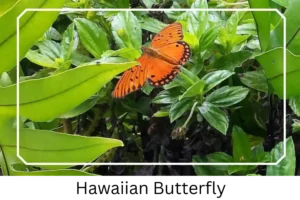Hawaiian (Vanessa tameamea)
The Hawaiian Butterfly, Vanessa tameamea, represents a unique and vibrant part of Hawaii’s rich biodiversity. Known for its striking colors and fascinating life cycle, this butterfly is not only a natural treasure but also a symbol of the island’s delicate ecosystem. Its existence alongside the Hawaiian Blue Butterfly underscores the ecological uniqueness of the Hawaiian archipelago.
Scientific Classification
- Family: Nymphalidae
- Genus: Vanessa
- Common names: Kamehameha
- Scientific Name: Vanessa tameamea
Overview
Endemic to the Hawaiian Islands, the Vanessa tameamea butterfly is a captivating sight. With its distinctive orange hue and patterns that mimic the Monarch Butterfly, it captures the essence of the island’s natural beauty. This species, named to honor Hawaii’s royal lineage, plays a crucial role in the local ecosystem, acting as a pollinator and a part of the food web. Through understanding its life stages—from the caterpillar to the majestic adult butterfly—we gain insights into the complexity of nature’s designs and the importance of conservation efforts.
Description and Identification
Caterpillar
The life of the Vanessa tameamea begins in a humble form, with the first instar larvae emerging small and black, adorned with tiny thorn-like protrusions. As it progresses through its instars, it transitions from black to green, then to white, and back to green, with some specimens even turning red. These caterpillars are meticulous in their feeding, nibbling at the edges of leaves from their host plants.
Pupa
The transformation continues as the caterpillar encapsulates itself within a chrysalis. Initially white with light brown patches, the chrysalis may also present a red variant, both types featuring similar patchy patterns, hinting at the transformation unfolding within.
Adult Butterfly
Upon reaching adulthood, the butterfly exhibits a subtle sexual dimorphism. The wings, when spread, reveal a vibrant peach-orange canvas bordered with black. Males boast light orange spots, while females display bright white ones against the black margins. The underside of the wings mimics a dead leaf, a camouflage against predators.
Sexual Dimorphism: Present but subtle.
Color and Appearance: Peach-orange wings with black borders and distinct spots.
Average Wingspan: Approximately 3 inches.
Flight Pattern: Medium-paced and almost straight.
Eggs
The beginning of the lifecycle, the eggs are minute, about 1 mm in diameter, laid individually on the leaves of host plants.
Quick Facts | |
| Distribution | Exclusively in Hawaii, USA. |
| Habitat | Prefers moist environments like gulches or streams rich in host plants. |
| Lifespan of Adults | Not known. |
| Host Plants | Primarily from the Urticaceae family |
| Adult Diet | Feeds on the sap of the Acacia koa |
How to Identify Hawaiian Butterfly?
Identifying the Hawaiian Butterfly involves recognizing its unique color patterns and behaviors. Look for the vibrant peach-orange wings with distinctive black borders and spot patterns that differ between males and females. Observing their flight pattern can also provide clues, as they tend to fly in a medium-paced, almost straight line. The presence of these butterflies often indicates the nearby abundance of their host plants, particularly in moist, gulch-like environments. Paying attention to these details will enhance your ability to spot and appreciate this remarkable species in its natural habitat.
Did You Know?
- The Vanessa tameamea is named in honor of the Hawaiian royal House of Kamehameha. The species’ discovery closely followed the death of Kamehameha V, marking a poignant connection between Hawaii’s natural heritage and its royal history.
- In Hawaiian, this butterfly is known as ‘pulelehua,’ a term that combines the concepts of floating in the air (‘pule’) and the colorful vibrancy of a rainbow (‘lehua’).
- The butterfly serves as an emblem for environmental and conservation efforts in Hawaii, highlighting the need to preserve the islands’ unique ecosystems and biodiversity.
Conclusion
The Vanessa tameamea is more than just a butterfly; it’s a symbol of Hawaii’s natural beauty and ecological diversity. Understanding its life cycle, habitat preferences, and the critical role it plays in the island’s ecosystem allows us to appreciate the importance of conservation efforts. By safeguarding its environment, we ensure that future generations can continue to marvel at this and other unique species, maintaining the delicate balance of our planet’s biodiversity.

Scientific Classification

- Family: Nymphalidae
- Genus: Vanessa
- Common names: Kamehameha
- Scientific Name: Vanessa tameamea




